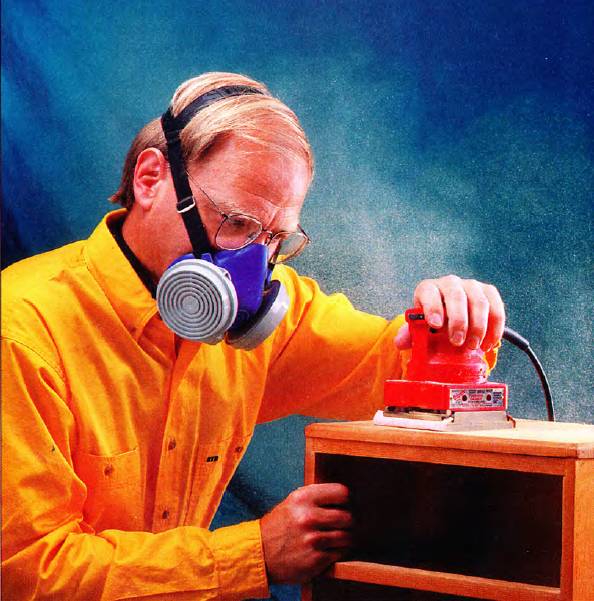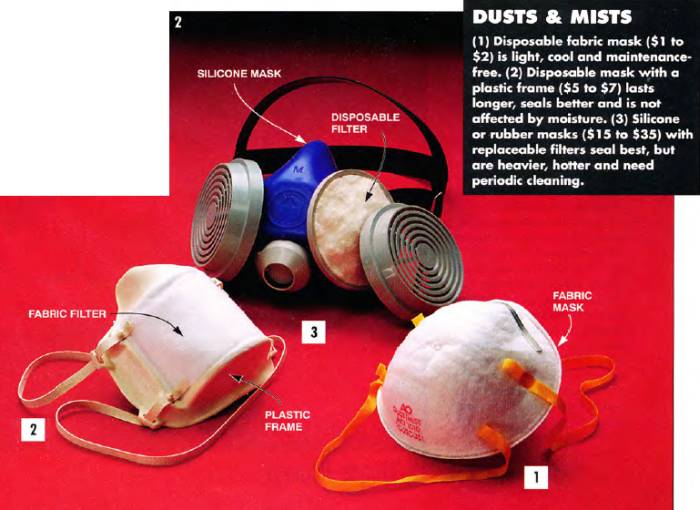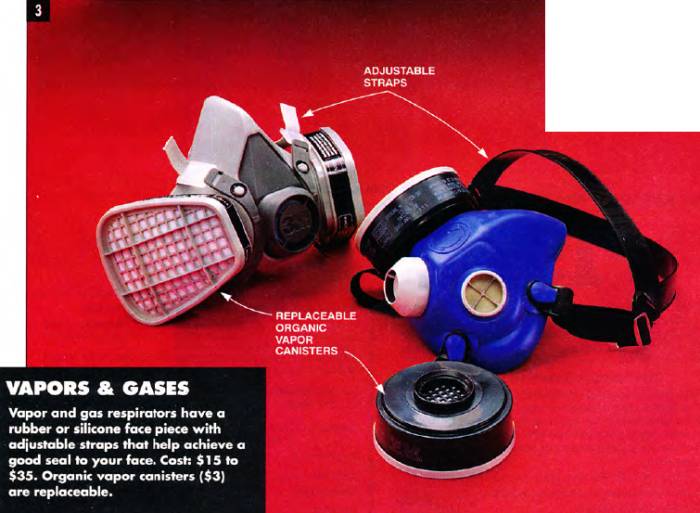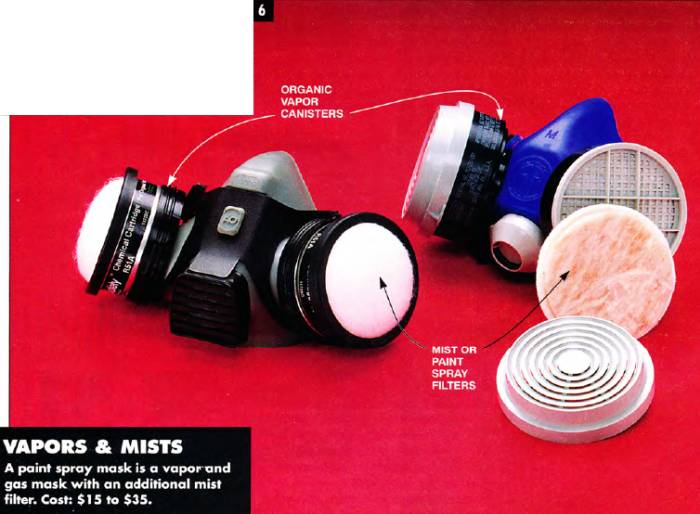Personal Protection Equipment (PPE): Choosing the right Respirators
I’ll make selecting the right respirator as easy as possible — so you’ll buy one and use it for your own good!
How often have you round yourself eyeball deep in clouds of dust, paint vapors or other airborne pollutants, while hard at work and home improvement project? Frequently, I’ll bet.
Fortunately, few home improvement materials release dangerous substances in high enough concentrations to become life-threatening. Lead dust from old paint and asbestos are two exceptions — call on trained experts to handle these.
Still, we can inhale enough bad stuff to cause throat irritations, headaches, coughing and other temporary discomforts.
A workspace with good dust collection and good ventilation is the best defense against these airborne pollutants. But you often need a good second defense too — a respirator.

In this article I will tell you what pollutants to watch out for and how to choose a respirator to protect yourself from them. Indeed, I make no bones about it. I think every homeowner should own and regularly use at least one, and perhaps several, of these respirators.
How to choose a respirator
Manufacturers make a variety of specialized masks that balance comfort, weight and cost with effective protection from specific pollutants. So to choose the best breathing protection, you have to know what substance you’re trying to stop.
Fortunately, most common pollutants fall into one of two easily recognized groups:
- Dusts and mists, and
- vapors and gases.
Dusts and mists
They are small, solid or liquid particles that float in the air yet can be easily trapped by a mesh filter. They include sawdust, drywall dust and dusts from various types of insulation. They can penetrate deeply into your lungs.
A rising dust or mist cloud is a good signal to put on a filtration device, But you often can’t see smaller dust particles like insulation fibers and metal dusts. You simply have to anticipate them and wear your dust mask for protection.

The picture shows three styles: two disposable types and a more expensive silicone mask with a replaceable filter. All work well if they fit well. For a mask to work, it must seal tightly to your face so pollutants can‘t leak in around the edges. Notice that all three masks have two straps to ensure a better seal. Masks with one strap, while better than nothing, can‘t make a good seal.
A dust mask’s filtration actually tends to improve as particles load up on the filter, but when breathing becomes more difficult, change the filter or discard the mask.
Vapors and gases
This second category of pollutants, vapors and gases, is made up of particles that are too small to be trapped in a mesh. Special charcoal filters (called “organic vapor” filters) chemically absorb these substances.
Most harmful vapors and gases around the home come from solvents that evaporate from paints and strong cleaning agents like paint thinner and paint stripper.
While you can’t see them, you can almost always smell them, which is your signal to check the container to determine if the vapors are hazardous. On most solvent containers you’ll find the word “DANGER” or some other warning followed by proper handling instructions.
You don’t want to breathe the vapors of any of these substances, so wear a special “organic vapor” respirator and maintain good ventilation in your work area.

The respirators in the picture have replaceable cartridges and adjustable straps so you can get a seal that’s tight to your face. If you begin to smell a solvent through your mask, the cartridge is worn out and should be changed.
Incidentally, methylene chloride, the traditional active ingredient in fast-acting paint strippers, is the most dangerous vapor you’re likely to encounter in home-use products So always ventilate well when using it and wear your organic vapor breathing device.
Paint spray and other pollutants
Whether they’re sprayed from a can or from a power sprayer, paint sprays create a fine mist in addition to paint vapors.
So the proper respirator combines the filtration of the two previous types of masks—a mist filter and an organic vapor filter (see pictures).

Neither one by itself will do the job. Smoke from burning wood, leaves, paper or tobacco contains both particles and vapors, so you’ll need a combination mask if you have to work in smoky areas.
But no filter or cartridge will stop smoke’s most dangerous component, carbon monoxide. So avoid smoke whenever possible.
Finally, some pollutants require special filtration. The most common and potentially dangerous of these are pesticides, substances that are extremely toxic. Don’t inhale any of this stuff, whether in dust form or in mists. Use a silicone or rubber mask and filters specifically rated for pesticide use.
You’ll also need special protection when you weld. In welding, some extremely toxic metals can vaporize and become suspended in the air as fumes. So wear a respirator that‘s specially rated for fumes.
Rating respirators
How do you know if a mask actually works? The best way is to buy only those masks carrying the official test mark “NIOSH Approved” (including a test number beginning with the letters TC). NIOSH stands for the National Institute for Occupational Safety and Health.
The mask and filtration device will list the categories of pollutants for which it’s approved: dusts, mists, vapors, fumes, gases, pesticides, paint mists, and/or others. This assures you that the mask or cartridge has been tested for these types of pollutants and meets official standards.
Finding a good respirator
You can usually find a variety of NIOSH-approved masks and respirators at home centers and full-service hardware stores. Often you’ll see the familiar single-strap fabric dust mask too. These are not approved and do not filter nearly as well as the two-strap styles.
But no matter how well the filter works, a respirator can do a good job only if it doesn’t leak. Each time you put your mask on, make sure it seals tightly to your face so air can’t leak in around the edges.
In general, the silicone or rubber masks that we show seal better than the fabric disposables. However, every face is unique. So you might have to try on several sizes or brands of silicone masks before you find one that seals well.
Unfortunately, many home centers and hardware stores carry only one size and brand, If you can’t get a good fit, go to a store that specializes in safety equipment to find a wider selection.
Incidentally. men with beards will probably not be able to get a good seal on any mask, no matter what they do.
If you buy a silicone or rubber mask, be sure to wipe it clean periodically and store it in a plastic bag.
My recommendation
I recommend that every DIYer buy a good-fitting silicone or rubber mask with two filtration attachments, one for dusts and mists and one for vapors and gases. You can combine them when you spray paint. That way you‘ll be sure to always have adequate protection.
But we also recommend that you keep some two-strap disposable dust masks handy too. These masks don’t cost much, and are ideal for a second person who’s watching or helping you work in a dusty room. In fact, you’ll also like them when you don’t feel like putting on that heavier, hotter silicone mask.
I’ll make selecting the right respirator as easy as possible — so you’ll buy one and use it for your own good!
How often have you round yourself eyeball deep in clouds of dust, paint vapors or other airborne pollutants, while hard at work and home improvement project? Frequently, I’ll bet.
Fortunately, few home improvement materials release dangerous substances in high enough concentrations to become life-threatening. Lead dust from old paint and asbestos are two exceptions — call on trained experts to handle these.
Still, we can inhale enough bad stuff to cause throat irritations, headaches, coughing and other temporary discomforts.
A workspace with good dust collection and good ventilation is the best defense against these airborne pollutants. But you often need a good second defense too — a respirator.

In this article I will tell you what pollutants to watch out for and how to choose a respirator to protect yourself from them. Indeed, I make no bones about it. I think every homeowner should own and regularly use at least one, and perhaps several, of these respirators.
How to choose a respirator
Manufacturers make a variety of specialized masks that balance comfort, weight and cost with effective protection from specific pollutants. So to choose the best breathing protection, you have to know what substance you’re trying to stop.
Fortunately, most common pollutants fall into one of two easily recognized groups:
- Dusts and mists, and
- vapors and gases.
Dusts and mists
They are small, solid or liquid particles that float in the air yet can be easily trapped by a mesh filter. They include sawdust, drywall dust and dusts from various types of insulation. They can penetrate deeply into your lungs.
A rising dust or mist cloud is a good signal to put on a filtration device, But you often can’t see smaller dust particles like insulation fibers and metal dusts. You simply have to anticipate them and wear your dust mask for protection.

The picture shows three styles: two disposable types and a more expensive silicone mask with a replaceable filter. All work well if they fit well. For a mask to work, it must seal tightly to your face so pollutants can‘t leak in around the edges. Notice that all three masks have two straps to ensure a better seal. Masks with one strap, while better than nothing, can‘t make a good seal.
A dust mask’s filtration actually tends to improve as particles load up on the filter, but when breathing becomes more difficult, change the filter or discard the mask.
Vapors and gases
This second category of pollutants, vapors and gases, is made up of particles that are too small to be trapped in a mesh. Special charcoal filters (called “organic vapor” filters) chemically absorb these substances.
Most harmful vapors and gases around the home come from solvents that evaporate from paints and strong cleaning agents like paint thinner and paint stripper.
While you can’t see them, you can almost always smell them, which is your signal to check the container to determine if the vapors are hazardous. On most solvent containers you’ll find the word “DANGER” or some other warning followed by proper handling instructions.
You don’t want to breathe the vapors of any of these substances, so wear a special “organic vapor” respirator and maintain good ventilation in your work area.

The respirators in the picture have replaceable cartridges and adjustable straps so you can get a seal that’s tight to your face. If you begin to smell a solvent through your mask, the cartridge is worn out and should be changed.
Incidentally, methylene chloride, the traditional active ingredient in fast-acting paint strippers, is the most dangerous vapor you’re likely to encounter in home-use products So always ventilate well when using it and wear your organic vapor breathing device.
Paint spray and other pollutants
Whether they’re sprayed from a can or from a power sprayer, paint sprays create a fine mist in addition to paint vapors.
So the proper respirator combines the filtration of the two previous types of masks—a mist filter and an organic vapor filter (see pictures).

Neither one by itself will do the job. Smoke from burning wood, leaves, paper or tobacco contains both particles and vapors, so you’ll need a combination mask if you have to work in smoky areas.
But no filter or cartridge will stop smoke’s most dangerous component, carbon monoxide. So avoid smoke whenever possible.
Finally, some pollutants require special filtration. The most common and potentially dangerous of these are pesticides, substances that are extremely toxic. Don’t inhale any of this stuff, whether in dust form or in mists. Use a silicone or rubber mask and filters specifically rated for pesticide use.
You’ll also need special protection when you weld. In welding, some extremely toxic metals can vaporize and become suspended in the air as fumes. So wear a respirator that‘s specially rated for fumes.
Rating respirators
How do you know if a mask actually works? The best way is to buy only those masks carrying the official test mark “NIOSH Approved” (including a test number beginning with the letters TC). NIOSH stands for the National Institute for Occupational Safety and Health.
The mask and filtration device will list the categories of pollutants for which it’s approved: dusts, mists, vapors, fumes, gases, pesticides, paint mists, and/or others. This assures you that the mask or cartridge has been tested for these types of pollutants and meets official standards.
Finding a good respirator
You can usually find a variety of NIOSH-approved masks and respirators at home centers and full-service hardware stores. Often you’ll see the familiar single-strap fabric dust mask too. These are not approved and do not filter nearly as well as the two-strap styles.
But no matter how well the filter works, a respirator can do a good job only if it doesn’t leak. Each time you put your mask on, make sure it seals tightly to your face so air can’t leak in around the edges.
In general, the silicone or rubber masks that we show seal better than the fabric disposables. However, every face is unique. So you might have to try on several sizes or brands of silicone masks before you find one that seals well.
Unfortunately, many home centers and hardware stores carry only one size and brand, If you can’t get a good fit, go to a store that specializes in safety equipment to find a wider selection.
Incidentally. men with beards will probably not be able to get a good seal on any mask, no matter what they do.
If you buy a silicone or rubber mask, be sure to wipe it clean periodically and store it in a plastic bag.
My recommendation
I recommend that every DIYer buy a good-fitting silicone or rubber mask with two filtration attachments, one for dusts and mists and one for vapors and gases. You can combine them when you spray paint. That way you‘ll be sure to always have adequate protection.
But we also recommend that you keep some two-strap disposable dust masks handy too. These masks don’t cost much, and are ideal for a second person who’s watching or helping you work in a dusty room. In fact, you’ll also like them when you don’t feel like putting on that heavier, hotter silicone mask.
